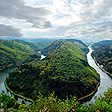HERMITAGE
CASTLE - SAAR
The Klause Kastel, Ex-Tomb of the Blind King
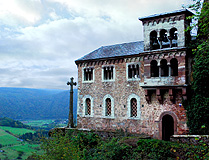 It’s
called a castle (kastel) but is more truly a church or monastery, or
just a chapel, the Hermitage, a solitary retreat which clings to the
rocky cliffs above
the winding Saar River. Founded by medieval monks during the times of
the Crusades, caves and chambers were burrowed into the soft sandstone
and at earlier holy site from the Romans and Celts before them. The caverns
evoked the finding of the Holy Cross in far away Jerusalem. One
of the niche caverns represented the Holy Sepulcher tomb, the “Heiliges
Grab”, next to other carved rooms for living and praying, so
the monks could imagine themselves praying in Golgotha.
It’s
called a castle (kastel) but is more truly a church or monastery, or
just a chapel, the Hermitage, a solitary retreat which clings to the
rocky cliffs above
the winding Saar River. Founded by medieval monks during the times of
the Crusades, caves and chambers were burrowed into the soft sandstone
and at earlier holy site from the Romans and Celts before them. The caverns
evoked the finding of the Holy Cross in far away Jerusalem. One
of the niche caverns represented the Holy Sepulcher tomb, the “Heiliges
Grab”, next to other carved rooms for living and praying, so
the monks could imagine themselves praying in Golgotha.
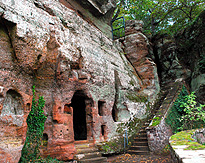 Fitting
with the austerity of the followers of Francis of Assisi, this lonely
place was
ideal to escape the world for silent contemplation with pathways
along the cliffs for meditation with wide views of the river valley
below.
The peacefulness of this vantage over the deep gorge of the Saar
Valley is still obvious. The Hermitage as seen now. with a chapel below
and
living chamber above was built around 1600, when the protestant Reformation
was sweeping Germany, with hermits living and praying in until the
time of Napoleon.
Fitting
with the austerity of the followers of Francis of Assisi, this lonely
place was
ideal to escape the world for silent contemplation with pathways
along the cliffs for meditation with wide views of the river valley
below.
The peacefulness of this vantage over the deep gorge of the Saar
Valley is still obvious. The Hermitage as seen now. with a chapel below
and
living chamber above was built around 1600, when the protestant Reformation
was sweeping Germany, with hermits living and praying in until the
time of Napoleon.
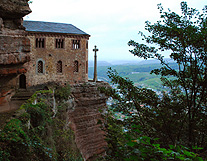 In
the 1800s, the site became the tomb for the bones of the legendary “Blind
King” of Bohemia, King John of Luxembourg. During the Hundred Years
War, French King Philip VI, called upon allies to join him against the
English forces of King Edward III. Despite having gone blind from opthalmia,
King John (Johann) answered the call, facing the English troops in the
Battle Crécy in 1346. In the course of the battle, John joined
the fray, linking arms with his knights to guide him, riding into the
battle to fight. He was killed in the hail of arrows from the English
longbows and the first use of cannons firing arrow quarrels, which wreaked
havoc on the French side. Victorious King Edward, a true believer in
chivalry, was so impressed by the blind king’s bravery, he had
his body entombed with all honors in the Benedictine Abbey of Luxembourg.
In
the 1800s, the site became the tomb for the bones of the legendary “Blind
King” of Bohemia, King John of Luxembourg. During the Hundred Years
War, French King Philip VI, called upon allies to join him against the
English forces of King Edward III. Despite having gone blind from opthalmia,
King John (Johann) answered the call, facing the English troops in the
Battle Crécy in 1346. In the course of the battle, John joined
the fray, linking arms with his knights to guide him, riding into the
battle to fight. He was killed in the hail of arrows from the English
longbows and the first use of cannons firing arrow quarrels, which wreaked
havoc on the French side. Victorious King Edward, a true believer in
chivalry, was so impressed by the blind king’s bravery, he had
his body entombed with all honors in the Benedictine Abbey of Luxembourg.
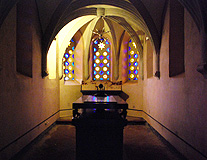 King Frederick William III of Prussia, while on a visit to the Rhineland
in 1833, touring the lands reclaimed for Germany in the 1815 Congress
of Vienna after the defeat of Napoleon at Leipzig in 1813, enamored of
the legend of his Bohemian ancestor the blind king, ordered his court
architect Karl Friedrich Schinkel to rebuild the Hermitage as a tomb.
Schinkel designed the reconstruction in the style of the Italian Renaissance,
all the rage at the time, adding the columned arch windows. The remains
of the long dead king were laid in the tomb, where they stayed until
the end of World War II, when they were transferred back to the Cathedral
of Luxemboug in 1946. The Chapel Room of the Hermitage remains in its
original medieval form with decorations from the 19th Century restoration
surrounding the place which once held the sarcophagus.
King Frederick William III of Prussia, while on a visit to the Rhineland
in 1833, touring the lands reclaimed for Germany in the 1815 Congress
of Vienna after the defeat of Napoleon at Leipzig in 1813, enamored of
the legend of his Bohemian ancestor the blind king, ordered his court
architect Karl Friedrich Schinkel to rebuild the Hermitage as a tomb.
Schinkel designed the reconstruction in the style of the Italian Renaissance,
all the rage at the time, adding the columned arch windows. The remains
of the long dead king were laid in the tomb, where they stayed until
the end of World War II, when they were transferred back to the Cathedral
of Luxemboug in 1946. The Chapel Room of the Hermitage remains in its
original medieval form with decorations from the 19th Century restoration
surrounding the place which once held the sarcophagus.
Visiting the Hermitage Castle - Klause Kastel
The
Hermitage castle site is best reached by car, not far from the Saar
River Loop viewpoint at Mettlach (see Saar
Loop View), Saarburg or nearby Lorraine,
France (see Dukes
of Lorraine Castle). Admission is €3 adult , €2.10
reduced, and €1.50 for children to 18 years. A combined ticket to
other historic sites in the area is available. The site is closed in
December and January
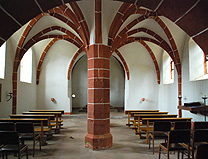 A path leads to the cliff from a parking area near the middle-ages
gothic arched Church of St John the Baptist (Johanneskirche), which
dates back to the 12th Century. This small church served as the local
village parish church until 1442, and today is dedicated as a memorial
to the fallen soldiers of WWII. The Kastel Path walking trail leads
aorung the little parkland along the cliff of the Saar to the remains
of an Oppidium, a Celtic trading settlement of the local Celtic “Trevari” predating
the conquest of the Saar region by Julius Caesar, when he was still
just a general in Germania (see Roman Villa Borg). © Bargain
Travel Europe
A path leads to the cliff from a parking area near the middle-ages
gothic arched Church of St John the Baptist (Johanneskirche), which
dates back to the 12th Century. This small church served as the local
village parish church until 1442, and today is dedicated as a memorial
to the fallen soldiers of WWII. The Kastel Path walking trail leads
aorung the little parkland along the cliff of the Saar to the remains
of an Oppidium, a Celtic trading settlement of the local Celtic “Trevari” predating
the conquest of the Saar region by Julius Caesar, when he was still
just a general in Germania (see Roman Villa Borg). © Bargain
Travel Europe
Best
hotel and vacation deals in Saarland on TripAdvisor
Web Info
Saar-Obermosel
Tourism
These articles are copyrighted and the sole property of Bargain Travel Europe and WLPV, LLC. and may not be copied or reprinted without permission.
See Also:
RHINE & MOSEL WINE FESTIVALS BY RAIL
ROMANESQUE CATHEDRAL OF SPEYER
MONASTERY BREWERY & WINE - BERNKASTEL-KUES

